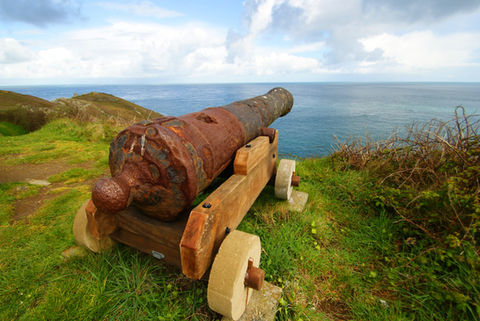Monks, Pirates & Folklore
Saints & Sinners
Sark's patron saint, St. Magloire, is said to have been gifted half of the island for miraculously curing a fatally ill Celtic Chieftain. Magloire retired to Sark in 565AD and, along with 60 fellow monks, built a monastery in the woods above Port Du Moulin bay. The monks' ancient well is still visible today near La Moinerie Hotel.
One of the most well-known stories about St. Magloire is how he rescued of a group of children who were playing in an abandoned wreck on the beach below the monastery when a sudden violent storm swept them out to sea. At the sound of their cries Magloire appeared and guided the boat back to safety before vanishing. The children were found the next morning by bemused fisherman.
Legend has it that St. Magloire led the monks in defending Sark from many Viking attacks but that eventually the monastery was destroyed during a raid led by the infamous Viking Chieftain, Jarl Hastein. For some 200 years afterwards the island remained uninhabited, a haven for pirates and wreckers, who with false lights would lure ships onto the surrounding rocks and plunder them.

Legend of the Coffin
Sark's own version of the Trojan Horse story has been around for centuries, since Sir Walter Raleigh wrote about it in his History of the World.
It tells of how a group of merchants, tired of being attacked by the troublesome pirates in Sark, planned a clever ambush. As the story goes, the merchants sailed to Sark and called out to the pirate sentries that their captain had died at sea. They requested to bury him in the sacred grounds of St. Magloire's chapel and offered a handsome reward.
The pirates agreed, on condition that the men landed unarmed. The merchants rowed ashore with only the coffin and hauled it up the steep cliff to the chapel, where they were allowed to hold a brief service in private.
Once inside the chapel, the merchants broke open the coffin, which was full of swords and longbows, and burst out of the building slaughtering everyone in sight.
The only survivor was an old woman who was baking bread at the time of the attack. Quickly grabbing a loaf, she ran to the Coupee, climbed down the Jersey side and hid in the Convache Chasm where she lived on her half-baked loaf until she was rescued by a Guernsey fisherman.


Witches, Pouquelayes and Folklore
Sark has long been revered as a place of magical and supernatural occurrences. Witchcraft was no exception. In the 1600s several accused witches were sent to the stake in Guernsey, including no less than five members of the Nicole family from Little Sark.
A firm belief in the dark art was prevalent on the island well into the 1900s, evidenced by the many houses built with 'witches' seats'. These protruding stones protected the home by offering visiting witches a place to rest and ensuring that they didn't fall down your chimney!
Up until the 1900s most islanders also believed in Pouquelayes, the sometimes helpful and often petulant Channel Island pixies who lived in the caves.Setting them apart from the others, the Sark Pouquelayes had detachable heads and enjoyed smoking pipes when not causing mischief!
Still today, the island attracts many alternative thinkers and practitioners from all walks of life. Traditional customs are still practiced within the community, including 'veilles', a tradition dating back to the middle ages where islanders gather in one building to pass the long winter night by knitting, crafting, singing and storytelling beside the fire.




